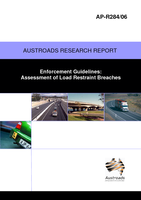Freight

Enforcement Guidelines: Assessment of Load Restraint Breaches
- Publication no: AP-R284-06
- ISBN: 1 921139 29 3
- Published: 15 February 2006
- PDF (free) Download
These guidelines are designed to support nationally consistent implementation of the national model legislative provisions of the Road Transport Reform (Compliance and Enforcement) Bill approved by Australian Transport Ministers in November 2003. One key concept contained in these model provisions is the risk based categorisation of load restraint breaches into minor, substantial and severe categories. The national model provisions also include the concept of the "chain of responsibility". This means that all those with responsibility for activities that affect compliance with road transport laws should be held legally accountable if they do not meet their obligations. This way, the effects of the actions, inactions and demands of off-the-road parties in the transport chain are recognised. For the first time, all parties in the chain - including, the consignor, packer, loader and receiver, as well as the driver and operator - must take positive steps to prevent a breach of the road transport mass, dimension and loading laws. All Australian jurisdictions are currently developing State or Territory based legislation in order to implement these Compliance and Enforcement (C&E;) provisions locally. In adapting these model guidelines locally, jurisdictions should refer to their specific legislative and regulatory frameworks. These model guidelines deal specifically with the assessment of load restraint breaches.
- AP-R284/06 Enforcement Guidelines: Assessment of Load Restraint Breaches
- CONTENTS
- 1. INTRODUCTION
- 2. LIMITS, BREACHES AND BREAKPOINTS
- Part A: Does the load positioning make the vehicle unsafe or unstable?
- Part B: Does the load securing system fail to meet the performancestandard?
- Part C: Has a loss-of-load occurred or is it imminent?
- Part D: Is there an appreciable risk of harm?
- INFORMATION RETRIEVAL
Related publications
WEB-R703-24
Latest Freight News
